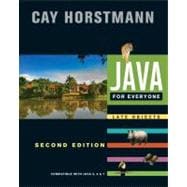
Note: Supplemental materials are not guaranteed with Rental or Used book purchases.
Purchase Benefits
Looking to rent a book? Rent Java For Everyone Late Objects [ISBN: 9781118063316] for the semester, quarter, and short term or search our site for other textbooks by Horstmann, Cay S.. Renting a textbook can save you up to 90% from the cost of buying.
1.1 Computer Programs
1.2 The Anatomy of a Computer
1.3 The Java Programming Language
1.4 Becoming Familiar with Your Programming Environment
1.5 Analyzing Your First Program
1.6 Errors
1.7 Problem Solving: Algorithm Design
Chapter 2 Fundamental Data Types
2.1 Variables
2.2 Arithmetic
2.3 Input and Output
2.4 Problem Solving: First Do it By Hand
2.6 Strings
Chapter 3 Decisions
3.1 The if Statement
3.2 Comparing Numbers and Strings
3.3 Multiple Alternatives
3.4 Nested Branches
3.5 Problem Solving: Flowcharts
3.6 Problem Solving: Test Cases
3.7 Boolean Variables and Operators
3.8 Application: Input Validation
Chapter 4 Loops
4.1 The while Loop
4.2 Problem Solving: Hand-Tracing
4.3 The for Loop
4.4 The do Loop
4.5 Application: Processing Sentinel Values
4.6 Problem Solving: Storyboards
4.7 Common Loop Algorithms
4.8 Nested Loops
4.9 Application: Random Numbers and Simulations
Chapter 5 Methods
5.1 Methods as Black Boxes
5.2 Implementing Methods
5.3 Parameter Passing
5.4 Return Values
5.5 Methods Without Return Values
5.6 Problem Solving: Reusable Functions
5.7 Problem Solving: Stepwise Refinement
5.8 Variable Scope
5.9 Recursive Methods (Optional)
Chapter 6 Arrays and Array Lists
6.1 Arrays
6.2 The Enhanced for Loop
6.3 Common Array Algorithms
6.4 Using Arrays with Methods
6.5 Problem Solving: Adapting Algorithms
6.6 Problem Solving: Discovering Algorithms by
Manipulating Physical Objects
6.7 Two-Dimensional Arrays
6.8 Array Lists
Chapter 7 Input/Output and Exception Handling
7.1 Reading and Writing Text Files
7.2 Processing Text Input
7.3 Command Line Arguments
7.4 Checked and Unchecked Exceptions
7.5 Catching Exceptions
7.6 The finally Clause
7.7 Application: Handling Input Errors
Chapter 8 Object and Classes
8.1 Object-Oriented Programming
8.2 Implementing a Simple Class
8.3 Specifying the Public Interface of a Class
8.4 Designing the Data Representation
8.5 Problem Solving: Patterns for Representing Behavior
8.6 Implementing Instance Methods
8.7 Constructors
8.8 Problem Solving: Tracing Objects
8.9 Testing a Class
8.10 Object References
8.11 Static Variables and Methods
Chapter 9 Inheritance
9.1 Inheritance Hierarchies
9.2 Implementing Subclasses
9.3 Overriding Methods
9.4 Polymorphism
9.5 Object: The Cosmic Superclass
9.6 Interface Types
Chapter 10 Graphical User Interfaces
10.1 Frame Windows
10.2 Events and Event Handling
10.3 Using Inheritance to Customize Frames
10.4 Building Applications with Buttons
10.5 Using Inner Classes for Listeners
10.6 Processing Text Input
10.7 Text Areas
===== Web chapters ==========================================
Chapter 11 Advanced Graphical User Interfaces
11.1 Layout Management
11.2 Choices
11.3 Menus
11.4 Exploring the Swing Documentation
11.5 Drawing on a Component
11.6 Using Timer Events for Animations
11.7 Mouse Events
Chapter 12 Object-Oriented Design
12.1 The Software Life Cycle
12.2 Discovering Classes
12.3 Relationships Between Classes
12.4 Cohesion and Coupling
12.5 Side Effects
12.5 Abstract Classes
12.6 Packages
12.7 Application: Printing an Invoice
12.8 Application: An Automatic Teller Machine
Chapter 13 Recursion
13.1 Triangle Numbers
13.2. Thinking Recursively
13.3 Recursive Helper Methods
13.4 The Efficiency of Recursion
13.5 Permutations
13.6 Mutual Recursions
13.7 Backtracking
Chapter 14 Sorting and Searching
14.1 Selection Sort
14.2 Profiling the Selection Sort Algorithm
14.3 Analyzing the Performance of the Selection Sort Algorithm
14.4 Merge Sort
14.5 Analyzing the Merge Sort Algorithm
14.6 Searching
14.7 Binary Search
14.8 Sorting Real Data
Chapter 15 The Java Collections Framework
15.1. An Overview of the Collections Framework
15.2. Linked Lists
15.3. Stacks, Queues, and Priority Queues
15.4. Sets
15.5. Maps
==== Appendices ==========================================
APPENDIX A THE BASIC LATIN AND LATIN-1 SUBSETS OF UNICODE
APPENDIX B JAVA OPERATOR SUMMARY
APPENDIX C JAVA RESERVED WORD SUMMARY
APPENDIX D THE JAVA LIBRARY
APPENDIX E JAVA SYNTAX SUMMARY (Online only)
APPENDIX F HTML SUMMARY (Online only)
APPENDIX G TOOL SUMMARY (Online only)
APPENDIX H JAVADOC SUMMARY (Online only)
The New copy of this book will include any supplemental materials advertised. Please check the title of the book to determine if it should include any access cards, study guides, lab manuals, CDs, etc.
The Used, Rental and eBook copies of this book are not guaranteed to include any supplemental materials. Typically, only the book itself is included. This is true even if the title states it includes any access cards, study guides, lab manuals, CDs, etc.